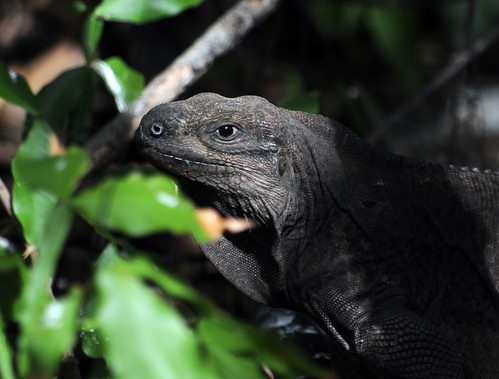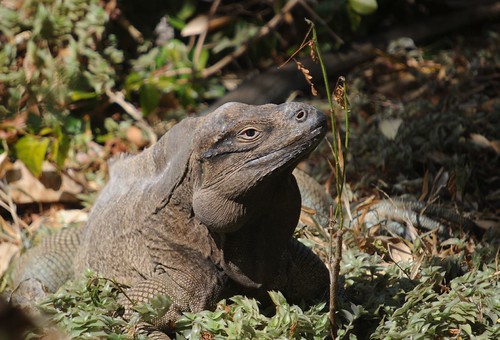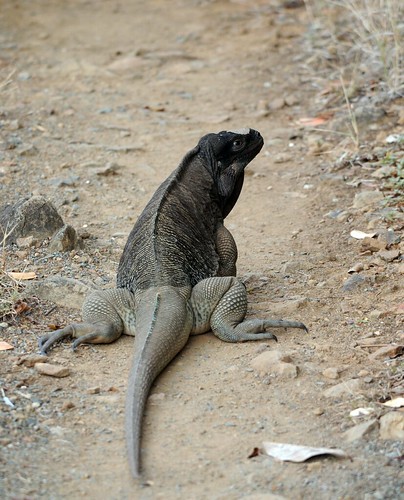Now, long time readers of the blog will know that as I get to travel the Caribbean I always look out for island or regional endemics, that is to say plants or animals with ranges limited to one or a small number of islands throughout the chain. As I have proven on a number of different occasions by far the coolest of the Caribbean endemic groups are the Cyclura or Rock Iguanas. Ranging in size from the largest lizard in the Americas to 2 and a bit feet this genus invariably provides the apex land herbivore on any island in which they are present. They look cool and are usually very endangered which makes trying to find and photograph them irresistible for me.
One species which has always troubled me however is the Anegada Ground Iguana or Stout Iguana (Cyclura pinguis). It was the first to feature on the blog when I visited its headstarting facility. It troubles me because I've visited its home island a number of times and only ever seen the tip of a tail disappearing rapidly. There are perhaps 3-400 of these creatures in the wild so it is not in a good state at all - that horned guan the lucky guatemala bloggers were trekking to hell and back for has a couple of thousand wild animals by contrast) the evidence from Anegada (even with headstarting) suggests they are struggling. Happily though they are no longer restricted to Anegada and I visited their other home island, Guana Island, recently. Guana is privately owned and is run as a combination of nature reserve and highly exclusive hotel. Being the International Playboy that I am, I took the missus for a long weekend of pampering, diving and nature hiking.
One species which has always troubled me however is the Anegada Ground Iguana or Stout Iguana (Cyclura pinguis). It was the first to feature on the blog when I visited its headstarting facility. It troubles me because I've visited its home island a number of times and only ever seen the tip of a tail disappearing rapidly. There are perhaps 3-400 of these creatures in the wild so it is not in a good state at all - that horned guan the lucky guatemala bloggers were trekking to hell and back for has a couple of thousand wild animals by contrast) the evidence from Anegada (even with headstarting) suggests they are struggling. Happily though they are no longer restricted to Anegada and I visited their other home island, Guana Island, recently. Guana is privately owned and is run as a combination of nature reserve and highly exclusive hotel. Being the International Playboy that I am, I took the missus for a long weekend of pampering, diving and nature hiking.

....and yes - we saw plenty of wild Stout Iguanas! I'd like to say this was difficult but truth be told one was lurking around the hotel when we arrived looking to persuade guests to part with some of their breakfast fruit salad (understand though - it wasn't begging (and Cyclura will learn to beg food); it was simply basking on a rock with the benefit of being nearish the breakfast table). The animal above though was the first one I saw truly out in the wild - seen hiking through thick scrub (Guana is dotted with well arranged trails to take in various habitats) and rather skittish. I failed to get photos of the biggest iguana we saw; an animal well over 6 feet bursting through the scrub alongside us when we disturbed it unwittingly (I also, some of the more serious naturalists among you will be disappointed to hear, did not take photos of the monumental piles of iguana scat we came across - indicative of a big, big animal).
As you can see though even the ones I did get images of were huge -like the above male. Much bigger than other Cyclura and its easy to see how this is the largest lizard in the Western Hemisphere.
They also have interesting patterning - the babies (of which more later) are beautiful and the males retain some blue but the females go very dark (like the above animal). More on these remarkable creatures and Guana Island to come....


2 comments:
They are so cool. Was the pampering just an excuse to get the future Mrs Tai Haku to come with you on an iguana hunt?
I'm sure your interest in Caribbean flora and fauna extends back into the fossil record, so thought you might be interested in the Caribbean Paleobiology blog if you haven't already come across it. Another palaeo-blogger linked to it.
Thanks Julia - the missus did say this was her favourite out of all our iguana hunts thus far for some reason...
I've only briefly checked out CP (I think I found it through TetZoo?) but I want to burrow through some of the linked papers - some of them have a bearing on some pleistocene referencing posts I want to do here at some point.
Post a Comment